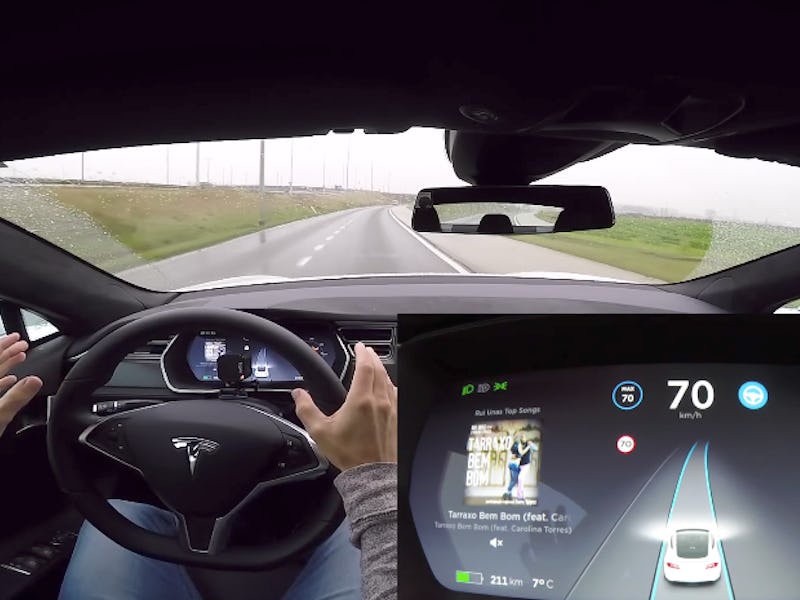In Year Since Fatal Tesla Crash, Car Autonomy Has Gone Mainstream
Every major automaker and ambitious start-ups are moving faster than ever.

On Friday, Tesla released a software update for vehicles that are equipped with second generation Autopilot. It bumps Autosteer’s highway speed limit up to 90 mph and off highway limit to 5 mph over the speed limit.
Elektrek reports that Tesla is also asking users to allow the company to collect short video clips using the cars’ external cameras. Tesla claims it won’t be able to identify what video clips belong to different models, and that the more on-the-road data they’re able to collect, the closer the company will be to a self-driving car reality.
Sunday also marks the one-year anniversary of Tesla’s Autopilot-related fatality. On May 7, 2016, Joshua Brown was killed when his Model S collided with a tractor-trailer near Williston, Florida, while using Autopilot. In January, the NHTSA cleared Tesla of wrongdoing in the crash. The final report noted that the car’s technology was not yet fully autonomous and that due to the perpendicular nature of the crash and the speed, Autopilot’s sensors were not provided adequate time to detect the hazard.
Still, the crash was a controversial moment for a company whose CEO Elon Musk has said that one of the fundamental purposes of autonomous vehicles is to decrease driver fatalities and accidents overall. Since the crash, Tesla has navigated safety concerns and continued to move toward its goal of a driverless future. The year since the crash has seen Tesla’s competitors launch aggressive efforts at autonomy and regulators at the state and federal level adopt formal guidelines for testing.
Below are a few of the biggest events in the rapidly evolving field of self-driving tech to occur since that crash a year ago.
Fully Autonomous Hardware
In October of 2016, Tesla announced that all new Tesla vehicles would now include the hardware necessary to be fully autonomous at a “safety level substantially greater than that of a human driver.”
Fast-Approaching Competition
Tesla may be seen as the leader in autonomous driving, but a lot of technology companies and automakers have started trying to get in on the action in the last twelve months.
- In August, Ford announced its plan to mass-produce autonomous vehicles within five years and have them on the road by 2021.
- In September, Uber launched a small run of its self-driving car service in Pittsburgh.
- The Chinese search engine Baidu began publicly testing its self-driving BMW3 in November at the World Internet Conference in Wuzhen, China. Google’s self-driving car project got a boost and a new name in December. In January, we got a first look at a self-driving Chevy Bolt EV, Hyundai debuted an autonomous car that’s also part of your house, and BMW released its own automated driving system in a BMW 5 Series Sedan prototype.
- Tesla also sued a start-up called Aurora Innovation in January, claiming the self-driving company stole data from Tesla in order to compete with the autonomy innovators.
- During a panel discussion in January, Ford CEO Mark Fields alluded to the Tesla accident’s ability to scare off progress on autonomous vehicles, saying, “The one fear I have is if anybody in this industry tries to jump the gun and maybe get a beta-test product out there that — God forbid — has an event, an accident or something, that’s going to cause people to pause.”
- In April, Cadillac announced that its CT6 sedans would come equipped with Super Cruise in 2018, a technology that will have hands-free driving.
Road Regulations
In September, the federal government released the first nation-wide set of rules for the manufacturing and sale of autonomous cars.
In March, the California DMV announced a new set of regulations for testing autonomous cars on public roads, as the state has essentially become the playground for self-driving innovators like Uber, Tesla, and Google. The announcement also outed all the other companies that were looking to test autonomous technology on California roads.
In April, Apple was added to the DMV’s list, implying that it is also now working more seriously on its brand of autonomous technology.
Hints About the Future
In April, Model 3 and Model S Teslas were spotted driving around with extra sensors, which could be used for compiling more data or facilitating an even more advanced Autopilot function.
At a TED talk in Vancouver on April 28, Musk expounded on a number of his current projects, as well as what we can expect from Autopilot in the near future. He said that Tesla cameras — models currently come equipped with eight — were the key to autonomous driving and that perfecting a “vision neural net” is a priority. “You can absolutely be super-human with just cameras,” Musk said. “You could probably do ten times better than humans with just cameras.”
He also said that Tesla was on track to start conducting self-driving car trips from New York to L.A. as soon as the end of 2017. Of course, regulations still inhibit this from becoming a consumer reality, but Musk says he’s getting close to bridging the technological gap that will sooth the public’s safety concerns. So much so, he believes that in two years Tesla owners will feel comfortable enough that they’ll even choose to sleep through most of a cross-country trip.
“The real trick of it is not how to make it work 99.9 percent of the time, if a car crashes one in 1,000 times you’re probably still not going to be comfortable falling asleep,” he said. “But if the car is unlikely to crash in 100 lifetimes, in 1,000 lifetimes, then people are probably like, ‘OK, wow, if I were to live a thousand lives, I would still most likely never experience a crash, then that would be ok.’”